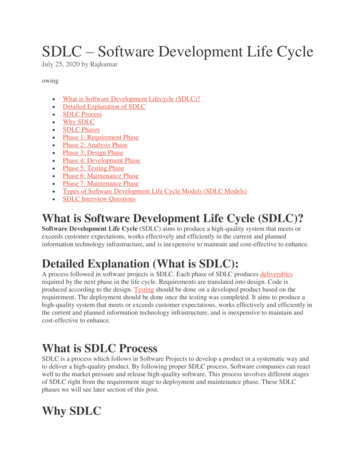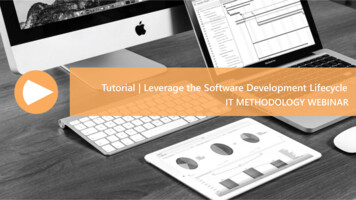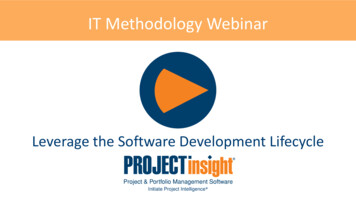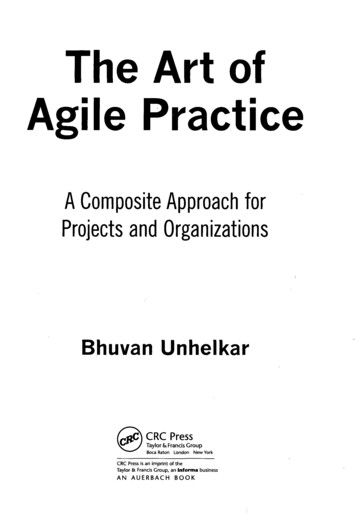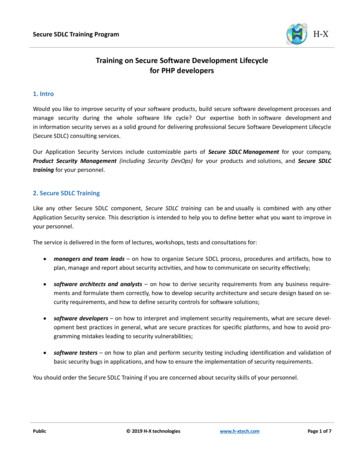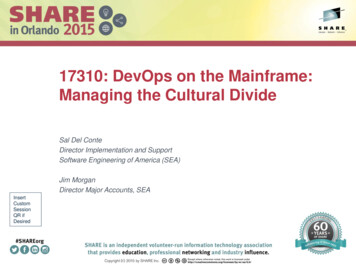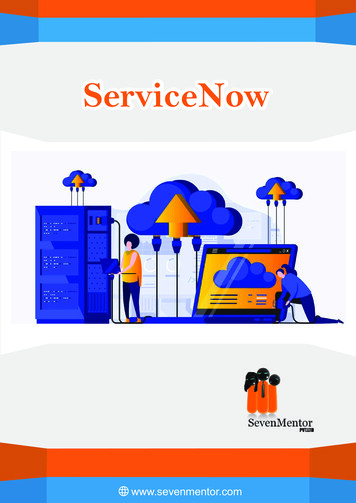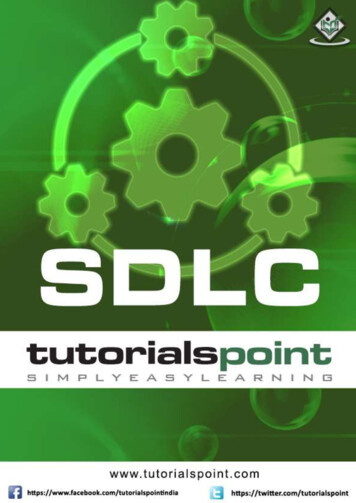
Transcription
SDLCi
SDLCAbout the TutorialSDLC stands for Software Development Life Cycle. SDLC is a process that consists of aseries of planned activities to develop or alter the Software Products. This tutorial will giveyou an overview of the SDLC basics, SDLC models available and their application in theindustry.This tutorial also elaborates on other related methodologies like Agile, RAD andPrototyping.AudienceThis tutorial is relevant to all those professionals contributing in any manner towardsSoftware Product Development and its release. It is a handy reference for the qualitystakeholders of a Software project and the program/project managers. By the end of thistutorial, the readers will develop a comprehensive understanding of SDLC and its relatedconcepts and will be able to select and follow the right model for any given Softwareproject.PrerequisitesThere are no specific prerequisites for this SDLC tutorial and any software professional cango through this tutorial to get a bigger picture of how the high-quality software applicationsand products are designed. A good understanding of programming or testing or projectmanagement will give you an added advantage and help you gain maximum from thistutorial.Copyright & Disclaimer Copyright 2017 by Tutorials Point (I) Pvt. Ltd.All the content and graphics published in this e-book are the property of Tutorials Point (I)Pvt. Ltd. The user of this e-book is prohibited to reuse, retain, copy, distribute or republishany contents or a part of contents of this e-book in any manner without written consentof the publisher.We strive to update the contents of our website and tutorials as timely and as precisely aspossible, however, the contents may contain inaccuracies or errors. Tutorials Point (I) Pvt.Ltd. provides no guarantee regarding the accuracy, timeliness or completeness of ourwebsite or its contents including this tutorial. If you discover any errors on our website orin this tutorial, please notify us at contact@tutorialspoint.comi
SDLCTable of ContentsAbout the Tutorial . iAudience . iPrerequisites . iCopyright & Disclaimer. iTable of Contents . ii1.SDLC – OVERVIEW . 1What is SDLC? . 1SDLC Models . 32.SDLC – WATERFALL MODEL . 4Waterfall Model Design . 4Waterfall Model Application . 5Waterfall Model Advantages . 6Waterfall Model Disadvantages . 63.SDLC – ITERATIVE MODEL. 7Iterative Model Design . 7Iterative Model Application . 8Iterative Model Pros and Cons . 84.SDLC – SPIRAL MODEL . 10Spiral Model Design. 10Spiral Model Application . 11Spiral Model Pros and Cons . 125.SDLC – V-MODEL . 13V-Model Design . 13V-Model Verification Phases . 14ii
SDLCCoding Phase . 14Validation Phases . 15V- Model Application . 15V-Model Pros and Cons . 166.SDLC – BIG BANG MODEL . 17Big Bang Model Design and Application . 17Big Bang Model Pros and Cons . 177.SDLC – AGILE MODEL . 18What is Agile? . 18Agile Vs Traditional SDLC Models . 20Agile Model Pros and Cons . 208.SDLC – RAD MODEL . 22What is RAD? . 22RAD Model Design . 22RAD Model Vs Traditional SDLC. 24RAD Model Application . 24RAD Model Pros and Cons . 249.SDLC – SOFTWARE PROTOTYPE MODEL . 26What is Software Prototyping? . 26Software Prototyping Types . 27Software Prototyping Application . 28Software Prototyping Pros and Cons . 28iii
1. SDLC – OverviewSDLCSoftware Development Life Cycle (SDLC) is a process used by the software industry todesign, develop and test high quality softwares. The SDLC aims to produce a high-qualitysoftware that meets or exceeds customer expectations, reaches completion within timesand cost estimates. SDLC is the acronym of Software Development Life Cycle. It is also called as Software Development Process. SDLC is a framework defining tasks performed at each step in the softwaredevelopment process. ISO/IEC 12207 is an international standard for software life-cycle processes. Itaims to be the standard that defines all the tasks required for developing andmaintaining software.What is SDLC?SDLC is a process followed for a software project, within a software organization. Itconsists of a detailed plan describing how to develop, maintain, replace and alter orenhance specific software. The life cycle defines a methodology for improving the qualityof software and the overall development process.The following figure is a graphical representation of the various stages of a typical SDLC.1
SDLCA typical Software Development Life Cycle consists of the following stages:Stage 1: Planning and Requirement AnalysisRequirement analysis is the most important and fundamental stage in SDLC. It isperformed by the senior members of the team with inputs from the customer, the salesdepartment, market surveys and domain experts in the industry. This information is thenused to plan the basic project approach and to conduct product feasibility study in theeconomical, operational and technical areas.Planning for the quality assurance requirements and identification of the risks associatedwith the project is also done in the planning stage. The outcome of the technical feasibilitystudy is to define the various technical approaches that can be followed to implement theproject successfully with minimum risks.Stage 2: Defining RequirementsOnce the requirement analysis is done the next step is to clearly define and document theproduct requirements and get them approved from the customer or the market analysts.This is done through an SRS (Software Requirement Specification) document whichconsists of all the product requirements to be designed and developed during the projectlife cycle.Stage 3: Designing the Product ArchitectureSRS is the reference for product architects to come out with the best architecture for theproduct to be developed. Based on the requirements specified in SRS, usually more thanone design approach for the product architecture is proposed and documented in a DDS Design Document Specification.This DDS is reviewed by all the important stakeholders and based on various parametersas risk assessment, product robustness, design modularity, budget and time constraints,the best design approach is selected for the product.A design approach clearly defines all the architectural modules of the product along withits communication and data flow representation with the external and third party modules(if any). The internal design of all the modules of the proposed architecture should beclearly defined with the minutest of the details in DDS.Stage 4: Building or Developing the ProductIn this stage of SDLC the actual development starts and the product is built. Theprogramming code is generated as per DDS during this stage. If the design is performedin a detailed and organized manner, code generation can be accomplished without muchhassle.Developers must follow the coding guidelines defined by their organization andprogramming tools like compilers, interpreters, debuggers, etc. are used to generate thecode. Different high level programming languages such as C, C , Pascal, Java and PHPare used for coding. The programming language is chosen with respect to the type ofsoftware being developed.2
SDLCStage 5: Testing the ProductThis stage is usually a subset of all the stages as in the modern SDLC models, the testingactivities are mostly involved in all the stages of SDLC. However, this stage refers to thetesting only stage of the product where product defects are reported, tracked, fixed andretested, until the product reaches the quality standards defined in the SRS.Stage 6: Deployment in the Market and MaintenanceOnce the product is tested and ready to be deployed it is released formally in theappropriate market. Sometimes product deployment happens in stages as per the businessstrategy of that organization. The product may first be released in a limited segment andtested in the real business environment (UAT- User acceptance testing).Then based on the feedback, the product may be released as it is or with suggestedenhancements in the targeting market segment. After the product is released in themarket, its maintenance is done for the existing customer base.SDLC ModelsThere are various software development life cycle models defined and designed which arefollowed during the software development process. These models are also referred as"Software Development Process Models". Each process model follows a Series of stepsunique to its type to ensure success in the process of software development.Following are the most important and popular SDLC models followed in the industry: Waterfall Model Iterative Model Spiral Model V-Model Big Bang ModelOther related methodologies are Agile Model, RAD Model, Rapid Application Developmentand Prototyping Models.3
2. SDLC – Waterfall ModelSDLCThe Waterfall Model was the first Process Model to be introduced. It is also referred to asa linear-sequential life cycle model. It is very simple to understand and use. In awaterfall model, each phase must be completed before the next phase can begin and thereis no overlapping in the phases. The Waterfall model is the earliest SDLC approach thatwas used for software development.The waterfall Model illustrates the software development process in a linear sequentialflow. This means that any phase in the development process begins only if the previousphase is complete. In this waterfall model, the phases do not overlap.Waterfall Model DesignWaterfall approach was first SDLC Model to be used widely in Software Engineering toensure success of the project. In "The Waterfall" approach, the whole process of softwaredevelopment is divided into separate phases. In this Waterfall model, typically, theoutcome of one phase acts as the input for the next phase sequentially.The following illustration is a representation of the different phases of the Waterfall Model.4
SDLCThe sequential phases in Waterfall model are: Requirement Gathering and analysis: All possible requirements of the systemto be developed are captured in this phase and documented in a requirementspecification document. System Design: The requirement specifications from first phase are studied in thisphase and the system design is prepared. This system design helps in specifyinghardware and system requirements and helps in defining the overall systemarchitecture. Implementation: With inputs from the system design, the system is firstdeveloped in small programs called units, which are integrated in the next phase.Each unit is developed and tested for its functionality, which is referred to as UnitTesting. Integration and Testing: All the units developed in the implementation phaseare integrated into a system after testing of each unit. Post integration the entiresystem is tested for any faults and failures. Deployment of system: Once the functional and non-functional testing is done;the product is deployed in the customer environment or released into the market. Maintenance: There are some issues which come up in the client environment. Tofix those issues, patches are released. Also to enhance the product some betterversions are released. Maintenance is done to deliver these changes in thecustomer environment.All these phases are cascaded to each other in which progress is seen as flowing steadilydownwards (like a waterfall) through the phases. The next phase is started only after thedefined set of goals are achieved for previous phase and it is signed off, so the name"Waterfall Model". In this model, phases do not overlap.Waterfall Model ApplicationEvery software developed is different and requires a suitable SDLC approach to be followedbased on the internal and external factors. Some situations where the use of Waterfallmodel is most appropriate are: Requirements are very well documented, clear and fixed. Product definition is stable. Technology is understood and is not dynamic. There are no ambiguous requirements. Ample resources with required expertise are available to support the product. The project is short.5
SDLCWaterfall Model AdvantagesThe advantages of waterfall development are that it allows for departmentalization andcontrol. A schedule can be set with deadlines for each stage of development and a productcan proceed through the development process model phases one by one.Development moves from concept, through design, implementation, testing, installation,troubleshooting, and ends up at operation and maintenance. Each phase of developmentproceeds in strict order.Some of the major advantages of the Waterfall Model are as follows: Simple and easy to understand and use Easy to manage due to the rigidity of the model. Each phase has specificdeliverables and a review process. Phases are processed and completed one at a time. Works well for smaller projects where requirements are very well understood. Clearly defined stages. Well understood milestones. Easy to arrange tasks. Process and results are well documented.Waterfall Model DisadvantagesThe disadvantage of waterfall development is that it does not allow much reflection orrevision. Once an application is in the testing stage, it is very difficult to go back andchange something that was not well-documented or thought upon in the concept stage.The major disadvantages of the Waterfall Model are as follows: No working software is produced until late during the life cycle. High amounts of risk and uncertainty. Not a good model for complex and object-oriented projects. Poor model for long and ongoing projects. Not suitable for the projects where requirements are at a moderate to high risk ofchanging. So, risk and uncertainty is high with this process model. It is difficult to measure progress within stages. Cannot accommodate changing requirements. Adjusting scope during the life cycle can end a project. Integration is done as a "big-bang. at the very end, which doesn't allow identifyingany technological or business bottleneck or challenges early.6
3. SDLC – Iterative ModelSDLCIn the Iterative model, iterative process starts with a simple implementation of a small setof the software requirements and iteratively enhances the evolving versions until thecomplete system is implemented and ready to be deployed.An iterative life cycle model does not attempt to start with a full specification ofrequirements. Instead, development begins by specifying and implementing just part ofthe software, which is then reviewed to identify further requirements. This process is thenrepeated, producing a new version of the software at the end of each iteration of themodel.Iterative Model DesignIterative process starts with a simple implementation of a subset of the softwarerequirements and iteratively enhances the evolving versions until the full system isimplemented. At each iteration, design modifications are made and new functionalcapabilities are added. The basic idea behind this method is to develop a system throughrepeated cycles (iterative) and in smaller portions at a time (incremental).The following illustration is a representation of the Iterative and Incremental model:Iterative and Incremental development is a combination of both iterative design oriterative method and incremental build model for development. "During softwaredevelopment, more than one iteration of the software development cycle may be inprogress at the same time." This process may be described as an "evolutionary acquisition"or "incremental build" approach."In this incremental model, the whole requirement is divided into various builds. Duringeach iteration, the development module goes through the requirements, design,implementation and testing phases. Each subsequent release of the module adds functionto the previous release. The process continues till the complete system is ready as per therequirement.7
SDLCThe key to a successful use of an iterative software development lifecycle is rigorousvalidation of requirements, and verification & testing of each version of the softwareagainst those requirements within each cycle of the model. As the software evolvesthrough successive cycles, tests must be repeated and extended to verify each version ofthe software.Iterative Model ApplicationLike other SDLC models, Iterative and incremental development has some specificapplications in the software industry. This model is most often used in the followingscenarios: Requirements of the complete system are clearly defined and understood. Major requirements must be defined; however, some functionalities or requestedenhancements may evolve with time. There is a time to the market constraint. A new technology is being used and is being learnt by the development team whileworking on the project. Resources with needed skill sets are not available and are planned to be used oncontract basis for specific iterations. There are some high-risk features and goals which may change in the future.Iterative Model Pros and ConsThe advantage of this model is that there is a working model of the system at a very earlystage of development, which makes it easier to find functional or design flaws. Findingissues at an early stage of development enables to take corrective measures in a limitedbudget.The disadvantage with this SDLC model is that it is applicable only to large and bulkysoftware development projects. This is because it is hard to break a small software systeminto further small serviceable increments/modules.The advantages of the Iterative and Incremental SDLC Model are as follows: Some working functionality can be developed quickly and early in the life cycle. Results are obtained early and periodically. Parallel development can be planned. Progress can be measured. Less costly to change the scope/requirements. Testing and debugging during smaller iteration is easy. Risks are identified and resolved during iteration; and each iteration is an easilymanaged milestone.8
SDLC Easier to manage risk - High risk part is done first. With every increment, operational product is delivered. Issues, challenges and risks identified from each increment can be utilized/appliedto the next increment. Risk analysis is better. It supports changing requirements. Initial Operating time is less. Better suited for large and mission-critical projects. During the life cycle, software is produced early which facilitates customerevaluation and feedback.The disadvantages of the Iterative and Incremental SDLC Model are as follows: More resources may be required. Although cost of change is lesser, but it is not very suitable for changingrequirements. More management attention is required. System architecture or design issues may arise because not all requirements aregathered in the beginning of the entire life cycle. Defining increments may require definition of the complete system. Not suitable for smaller projects. Management complexity is more. End of project may not be known which is a risk. Highly skilled resources are required for risk analysis. Projects progress is highly dependent upon the risk analysis phase.9
4. SDLC – Spiral ModelSDLCThe spiral model combines the idea of iterative development with the systematic,controlled aspects of the waterfall model. This Spiral model is a combination of iterativedevelopment process model and sequential linear development model i.e. the waterfallmodel with a very high emphasis on risk analysis. It allows incremental releases of theproduct or incremental refinement through each iteration around the spiral.Spiral Model DesignThe spiral model has four phases. A software project repeatedly passes through thesephases in iterations called Spirals.IdentificationThis phase starts with gathering the business requirements in the baseline spiral. In thesubsequent spirals as the product matures, identification of system requirements,subsystem requirements and unit requirements are all done in this phase.This phase also includes understanding the system requirements by continuouscommunication between the customer and the system analyst. At the end of the spiral,the product is deployed in the identified market.DesignThe Design phase starts with the conceptual design in the baseline spiral and involvesarchitectural design, logical design of modules, physical product design and the final designin the subsequent spirals.Construct or BuildThe Construct phase refers to production of the actual software product at every spiral. Inthe baseline spiral, when the product is just thought of and the design is being developeda POC (Proof of Concept) is developed in this phase to get customer feedback.Then in the subsequent spirals with higher clarity on requirements and design details aworking model of the software called build is produced with a version number. These buildsare sent to the customer for feedback.Evaluation and Risk AnalysisRisk Analysis includes identifying, estimating and monitoring the technical feasibility andmanagement risks, such as schedule slippage and cost overrun. After testing the build, atthe end of first iteration, the customer evaluates the software and provides feedback.The following illustration is a representation of the Spiral Model, listing the activities ineach phase.10
SDLCBased on the customer evaluation, the software development process enters the nextiteration and subsequently follows the linear approach to implement the feedbacksuggested by the customer. The process of iterations along the spiral continues throughoutthe life of the software.Spiral Model ApplicationThe Spiral Model is widely used in the software industry as it is in sync with the naturaldevelopment process of any product, i.e. learning with maturity which involves minimumrisk for the customer as well as the development firms.The following pointers explain the typical uses of a Spiral Model: When there is a budget constraint and risk evaluation is important. For medium to high-risk projects. Long-term project commitment because of potential changes to economic prioritiesas the requirements change with time. Customer is not sure of their requirements which is usually the case. Requirements are complex and need evaluation to get clarity. New product line which should be released in phases to get enough customerfeedback. Significant changes are expected in the product during the development cycle.11
SDLCSpiral Model Pros and ConsThe advantage of spiral lifecycle model is that it allows elements of the product to beadded in, when they become available or known. This assures that there is no conflict withprevious requirements and design.This method is consistent with approaches that have multiple software builds and releaseswhich allows making an orderly transition to a maintenance activity. Another positiveaspect of this method is that the spiral model forces an early user involvement in thesystem development effort.On the other side, it takes a very strict management to complete such products and thereis a risk of running the spiral in an indefinite loop. So, the discipline of change and theextent of taking change requests is very important to develop and deploy the productsuccessfully.The advantages of the Spiral SDLC Model are as follows: Changing requirements can be accommodated. Allows extensive use of prototypes. Requirements can be captured more accurately. Users see the system early. Development can be divided into smaller parts and the risky parts can be developedearlier which helps in better risk management.The disadvantages of the Spiral SDLC Model are as follows: Management is more complex. End of the project may not be known early. Not suitable for small or low risk projects and could be expensive for small projects. Process is complex Spiral may go on indefinitely. Large number of intermediate stages requires excessive documentation.12
5. SDLC – V-ModelSDLCThe V-model is an SDLC model where execution of processes happens in a sequentialmanner in a V-shape. It is also known as Verification and Validation model.The V-Model is an extension of the waterfall model and is based on the association of atesting phase for each corresponding development stage. This means that for every singlephase in the development cycle, there is a directly associated testing phase. This is ahighly-disciplined model and the next phase starts only after completion of the previousphase.V-Model DesignUnder the V-Model, the corresponding testing phase of the development phase is plannedin parallel. So, there are Verification phases on one side of the ‘V’ and Validation phaseson the other side. The Coding Phase joins the two sides of the V-Model.The following illustration depicts the different phases in a V-Model of the SDLC.13
SDLCV-Mod
SDLC 1 Software Development Life Cycle (SDLC) is a process used by the software industry to design, develop and test high quality softwares. The SDLC aims to produce a high-quality software that meets or exceeds customer expectations, reaches completion within times and cost estimates. SDLC is the acronym of Software Development Life Cycle.

